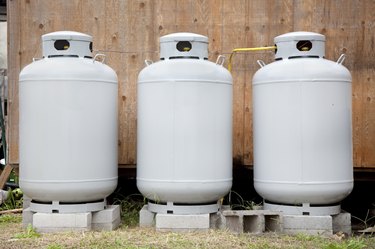Propane tanks come in a wide variety of sizes because they're used for so many different things. They're identified either by weight, as with a standard 20-pound barbecue grill tank, or by the amount of liquid propane they hold, as with a 500-gallon propane tank. No matter how they're identified, propane tanks are filled only to 80 percent of their capacity. This allows for safe expansion of the propane inside.

Video of the Day
Portable Home Propane Tanks
If you use small amounts of propane in a handful of home appliances, you're likely already familiar with the portable and popular 20-pound propane tank. About 1 1/2 feet tall and 1 foot wide, these tanks hold 5 gallons of propane. They work well for barbecue grills, patio heaters and mosquito catchers. Because they're so portable, users take their empty tank to a local store and simply exchange it for a full one rather than refilling it.
Video of the Day
If you're an avid barbecue enthusiast or use propane to fuel a fireplace, stove or clothes dryer, you may need a 100-pound tank. Holding 25 gallons when full, 100-pound tanks last much longer than their 20-pound counterparts but are small enough to work around the legal placement restrictions that affect larger tanks. The only requirement for these tanks is that you place them at least 3 feet from doors or windows and 5 feet from an ignition source.
Like 20-pound tanks, 100-pound tanks are exchanged rather than refilled. They're considered portable, but it's smart to have a buddy help you lift and move these tanks to prevent injury or strain.
33-Pound Propane Tanks
Approximately 2 feet tall and 1 foot wide, 33-pound tanks are a special size commonly used by propane-powered forklifts and small vehicles. These tanks hold about 8 gallons of propane and, like residential tanks, are usually exchanged when empty.
These tanks are available in the typical configuration in which the tank stands upright and releases propane gas. They're also available in a liquid draw format. In this setup, the tank mounts horizontally, and the appliance it powers draws liquid propane from the tank rather than gas. Liquid draw is commonly used for forklifts.
500- and 1,000-Gallon Propane Tanks
If you use propane in a small commercial enterprise or to heat your home, or if you own mostly gas appliances, a portable tank isn't likely to hold enough propane. You'll need a larger 500-gallon propane tank. Holding approximately 400 gallons when full due to the 80 percent rule, a 500-gallon tank will generally suffice for a 2,500 to 4,500 square-foot home. These propane tanks measure 3 1/2 feet in diameter and 10 feet long.
For safety reasons, 500-gallon propane tanks need to be placed at least 10 feet away from the nearest building and 10 feet away from any ignition sources. Some municipalities have stricter rules, however, and may also require that you place propane tanks away from property lines as well as structures. You can place a 500-gallon tank above ground or choose to bury it. Whichever option you choose, make sure you're following all of your area's code restrictions and rules.
If 500 gallons isn't quite enough for your home or business, 1,000-gallon tanks are also available. These tanks hold 800 gallons of propane and measure 3 1/2 feet around and 16 feet long. If you place two of these tanks within 3 feet of each other, they must be at least 25 feet away from buildings and ignition sources. Otherwise, 1,000-gallon tanks are generally subject to the same placement restrictions as 500-gallon tanks, but it's always best to double check and ensure code compliance.
The 30,000-Gallon Giant
Measuring an impressive 10 feet around and 70 feet long, 30,000-gallon propane tanks hold 24,000 gallons of propane when full. You won't see this propane cylinder size in your backyard. These commercial cylinders are instead used to hold large amounts of propane at propane storage facilities and sometimes make their way to large industrial sites. They're also used in housing communities who share one propane tank and then use gas meters to measure the propane usage of individual homes and offices.